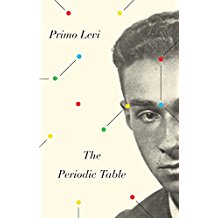The Periodic Table, Primo Levi 1975
Levi is known as perhaps the premier witness to the Holocaust through his two memoirs,Survival in Auschwitz (1958) and The Reawakening (1963). This memoir, written 30 years after the end of WWII is quite different in content, style, and tone. A chemist by education and occupation, Levi draws upon the periodic table of the elements created by Mendeleev 150 years ago which organized the basic building blocks of matter by their atomic number, the number of protons in the nucleus sorting elements into groups which shared common characteristics, e.g. the inert, noble gases, the metals, etc. Levi used his knowledge of chemistry to write this idiosyncratic memoir, associating 21 different elements with individuals and experiences from his life. In 21 chapters, each named for an element, Levi takes the reader from his family, residents of the Piedmont since the early 19th C (Argon) , to his time with the partisans during the WWI (Gold), to his time in a forced labor camp in Germany (Cerium) , and finally to his return to Turin where he married and started a new life (Vanadium). Chemistry is the thread that connects all of these experiences, and it is done through masterful writing. Alternately funny and tragic, ironic and serious, Levi writes with clarity, beauty, and sensitivity, and each essay has sentences that one wants to copy down and return to as Levi struggles to align the solidity and reality of Matter with the mystery of Spirit. One writer has described the accomplished essayist as a person you would wish to share conversations with, and Levi fits that description perfectly. One comes away from the book impressed with his courage, his strength, his human compassion, and his superb skill as a writer. This is a book worth reading again (this was my second reading of this work).



